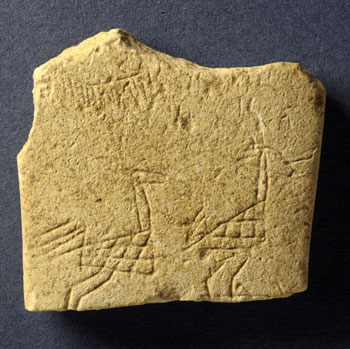(Communicated by the Israel Antiquities Authority)
A treasure of impressive prehistoric finds was exposed during the course of
archaeological excavations the Israel Antiquities Authority conducted this past
year,on behalf of the National Roads Company, prior to the widening of Highway
79 in northern Israel. The excavations encompass a large area covering a
distance of c. 800 m, on both sides of the road.
Prehistoric settlement remains that range in date from the Pre-Pottery
Neolithic period (c. 10,000 years ago) to the Early Bronze Age (c. 5,000 years
ago) are at the Ein Zippori site, which extends south of Ein Zippori spring.
According to Dr. Ianir Milevski and Nimrod Getzov, excavation directors on
behalf of the Israel Antiquities Authority, "The excavation revealed remains of
an extensive settlement from the end of the Neolithic period and beginning of
the Chalcolithic period in the country belonging to the "Wadi Rabah" culture.
This culture is named after the site where it was first discovered (in the
region of Rosh Ha-Ayin), and is common in Israel from the end of the sixth
millennium and beginning of the fifth millennium BCE."
According to the excavators, "The presence of remains from the Wadi Rabah
culture in most of our excavation areas and in surveys that were performed
elsewhere at the site shows that Ein Zippori is an enormous site that stretched
across c. 200 dunams. It turns out that this antiquities site is one of
the largest, if not the largest, in the country where there are remains of this
culture. The architecture is rectangular and the floors were made of
crushed chalk or very small stones. The foundations were made of stone and the
walls above them were built of mud bricks."
A multitude of artifacts has been uncovered in the excavation, including
pottery, flint tools, basalt vessels and artistic objects of great
importance. Milevski and Getzov said, "Pottery bearing features
characteristic of the Wadi Rabah culture such as painted and incised decorations
and red and black painted vessels were exposed."
"Outstanding among the flint tools that were discovered are the
sickle blades that were used to harvest grain, indicating the
existence of an agricultural economy. We also found flint axes
that were designed for working wood. The barter that transpired at the time is
attested to by thin sharp blades made of obsidian, a volcanic stone that is not
indigenous to the region and the closest source is in Turkey. These items
constituted part of the network of trade that stretched over thousands of
kilometers in such an ancient period."
Among the special finds that were uncovered in the excavation is a group of
small stone bowls that were made with amazing delicacy. One of them was
discovered containing more than 200 black, white and red stone beads. Other
important artifacts are clay figurines of animals (sheep, pig and cattle) that
illustrate the importance of animal breeding in those cultures.
The most importance finds are stone seals or amulets bearing
geometric motifs and stone plaques and bone objects decorated
with incising.

Photo: Clara Amit, courtesy of the Israel Antiquities
Authority
Among the stone plaques is one that bears a simple but very elegant carving
depicting two running ostriches. These objects represent the world of religious
beliefs and serve as a link that connects Ein Zippori with the cultures of these
periods in Syria and Mesopotamia. According to Milevski and Getzov, "The arrival
of these objects at the Ein Zippori site shows that a social stratum had already
developed at that time that included a group of social elite which used luxury
items that were imported from far away countries."